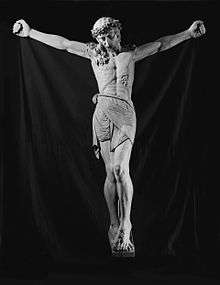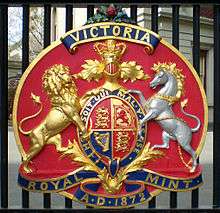Walter Langcake
Walter Langcake (21 February 1889, Warragul, Victoria – 6 June 1967, Frankston, Victoria) was an Australian woodcarver and sculptor, who specialised in ecclesiastical decorative arts.
Eagle lectern carved in wood by Walter Langcake, showing Germanic influence of his training. |
Walter Langcake | |
|---|---|
Walter Langcake in the 1920s | |
| Born | Walter Langcake 21 February 1889 Warragul, Victoria, Australia |
| Died | 6 June 1967 (aged 78) Frankston, Victoria, Australia |
| Nationality | Australian |
| Known for | Sculpture; decorative arts |
| Movement | Arts and crafts |
He was active between 1912 and the mid-1960s and was one of the last of the classical school of carvers produced in Australia. Many of his commissions adorn major city cathedrals, public buildings and memorials.
His grandfather migrated to Victoria from England in 1852 to prospect in the Castlemaine goldfields. Although Langcake's parents were not artistic, he was apprenticed in his mid-teens to a German immigrant woodcarver. In 1913 he married Elsie Isabel Johnson and they had four daughters; one dying in infancy.
As a young man he took the pledge of the Independent Order of Rechabites, which promoted temperance in Melbourne at the turn of the 20th century. His abstinence was so strict, he refused to enter public houses even for meals.
Langcake was also a lifelong rationalist and became a trusted mentor to the younger anarchist writer Arthur "Bluey" Howells (1907–86), who was involved in the anti-Franco and pacifist movements between the wars. When Langcake's first grandson was born at the outbreak of World War II, he wryly observed "more cannon fodder".
His original Therry st. shopfront studio off Queen Victoria Market was the unusual setting for informal gatherings of Melbourne's radicals and progressives. By the mid-30s, Langcake's business was successful enough for him to move into more upmarket premises in the Queen Street Law Chambers building.
He specialised in near life-sized figures of Christ on the cross, eagle lecterns, cathedra, bas reliefs, commemorative plaques and coats of arms, but could also produce charmingly informal works, often decorative castings for hotels or unique private commissions, adorned with Australiana flora and fauna. Langcake frequently worked with the prolific church architect Louis R. Williams (1890–1980) on major projects around Australia.
He was entrusted to sculpt unique heritage logs of exceptional age (greater than 1,000 years), beauty, circumference or cultural significance. He often sourced his exotic wood from North Queensland old-growth forests.
Langcake was also skilled in all aspects of cabinetry; creating fine articles of carved wooden furniture. His technique for alloy pieces was creation in wood and realization in cast metal, usually bronze (e.g. the Australian American War Memorial wreath).
During the 1940s he also taught woodcarving to trade students at Collingwood Technical School. Howells praised his artistry as a true sculptor in wood.

In the early 1960s Langcake moved from inner Melbourne to Frankston on the Mornington Peninsula to live next to one of his daughters. His modest workshop full of wood shavings, jars of preserved insects or the odd snake, and old copies of Australian Walkabout magazine for inspiration, was built at the back of his house. He died in his sleep of a heart attack in 1967.
Representative Works
Some of his major known works on public display include:
 Coat of arms on gates of the Royal Melbourne Mint
Coat of arms on gates of the Royal Melbourne Mint- "The Pelican in Her Piety", timber panel bas relief, 1959, St. John's Church, Camberwell, Vic.
- Bronze wreath at base of Australian American War Memorial, Canberra
 Entrance sign of the National Gallery of Victoria, St Kilda Road, Melbourne
Entrance sign of the National Gallery of Victoria, St Kilda Road, Melbourne Langcake finishing the Aquinas' figure (opposite)
Langcake finishing the Aquinas' figure (opposite)
- Coat of arms on gates of old Royal Melbourne Mint, crn. William and Latrobe Street
- Wreath at base of Australian American War Memorial, Canberra
- Baptismal font cover, St Paul's Cathedral, Melbourne
- Stations of the Cross, St Patrick's Cathedral, Melbourne
- National Gallery of Victoria front entrance lettering above the moat, St Kilda Road
- Life-sized figure of Christ in Queensland beech wood, 1937, that surmounts the reredos of the altar in St. Thomas Aquinas' Church, South Yarra, Victoria
- Carved mitre, relief panel of eagle on a lectern, and St Alban's shield, Anglican Cathedral Church of St. Alban the Martyr, Griffith, New South Wales
- Two Queensland black bean wood memorials with ecclesiastical emblems, Presbyterian Church of Armadale, Victoria
- Bishop's throne, St James' Cathedral, Townsville, Queensland
- "The Pelican in Her Piety," timber panel bas relief, 1959, St John's Anglican Church, Camberwell, Victoria
- Shire of Hastings Coat of arms, Hastings, Victoria
- Lectern, St Paul's Anglican Church, Frankston
- Lectern, St Luke's Church, Frankston
- Original communion table and pew end carvings, St Andrew's Church, Frankston
- Pew ends carved with ships' badges of the Royal Australian Navy, St Mark's chapel, HMAS Cerberus, Crib Point, Victoria
- Pew ends decorated with Australian animals and birds, chapel, former Burwood Boys Home, Burwood, Victoria
- 1939–1945 War Memorial Panel surmounted by cabinet with Christ figure on the cross, the Lady chapel of St Jude's Anglican Church, Brighton, South Australia
- Australian Army memorial gate plaques dedicated to 1st Division of United States Marine Corps following the Battle of Guadalcanal, outside former Balcombe Army Base, Mount Martha, Victoria (now entrance to Mace oval and on display in reception area of Mt. Martha House Community Center)
References
- Howells, Arthur F. Against the Stream: the memoirs of a philosophical anarchist, 1927–1939. Hyland House, Melbourne 1983.
- The Sun News-Pictorial (Melbourne, Victoria): Saturday, 21 February 1937, Wood Carvers Must be in the Mood.
- The Argus (Australia) [defunct newspaper] (Melbourne, Victoria): Monday, 27 March 1939, p. 2, Memorials Dedicated at Armadale Presbyterian Church.
- Anglican Cathedral Church of St. Alban the Martyr, Griffith, New South Wales, A Guided Tour of the Cathedral.
- Arthur Fenton Howells Collection (1932–57), Accession No. 2003.0024, The University of Melbourne Archives, Historical Note and Inventory List, 2/3 – C Correspondence, items 3,4 & 7, letters to Walter Langcake, 1937.
- Hali, Anam. Come See the Enchanting National Gallery of Victoria. 14 October 2011, London, TravelHouse UK News.
- Andrews, Brian. Australian Gothic: the Gothic revival in Australian architecture from the 1840s to the 1950s, 2001.
- Landmarks—Australian American War Memorial, CabBerra magazine, Issue #7, April 2013, p. 24
- Townsville Daily Bulletin [Qld defunct newspaper]: Tuesday, 20 May 1952, p. 2, N.Q. Cedar for Bishop's Throne.
- Wally Langcake entry and image of "The Pelican in Her Piety", Australian Anglican Historical Images – Fittings – Post World War II.
- SA Virtual War Memorial, Returned & Services League of Australia, SA Branch website, entry and image of Brighton memorial 02 at St. Jude's Anglican Church.
- The Argus (Melb. Vic): Monday, 20 December 1852, p. 5, an account of the Thorwaldsen incident at sea.
- Victorian Electoral Rolls – Castlemaine & District (Carisbrook, 14 May 1856), Thomas Read Langcake's listing as miner.
- Australia Birth Index, 1788–1922: Walter Langcake entry.
- Australia Marriage Index, 1788–1950: Walter Langcake and Isabel Elsie Johnson. 1913 – Victoria.
- 1924 Australian Electoral Roll: Entry for Langcake, Walter, Scott st., Cheltenham, carver. M.